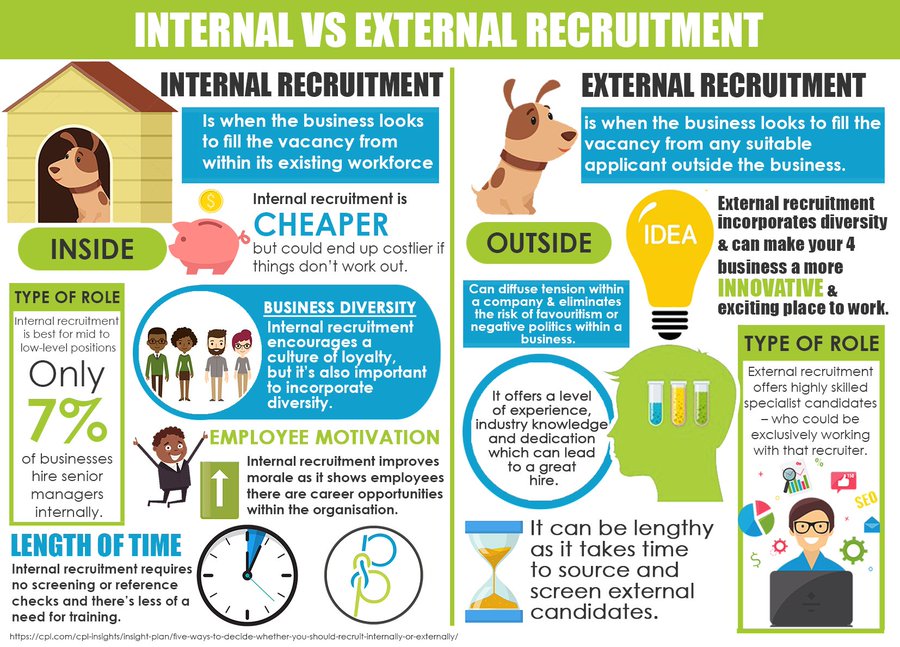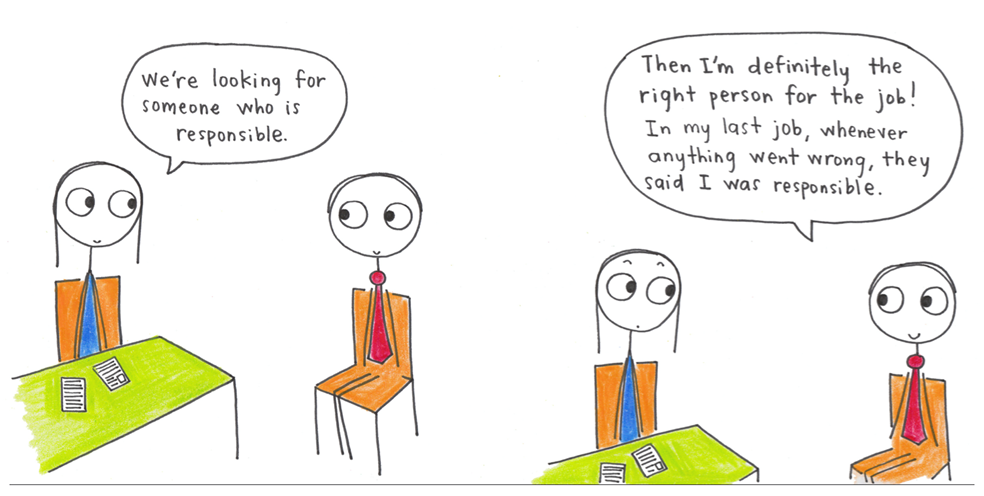We can categorise Human Resource Management (HRM) activities into five main areas as below. Within each area, you will find the main HRM functions, which we will discuss throughout the rest of this module.
Watch this video
It is a selection of TV and film clips that cover different functions within HRM. (2:53)
We will now look at the five (5) areas of HRM and learn more about the functions within each area.
| Staffing | Managing People and Performance | Developing People and Performance | Rewarding People and Performance | Managing Employment and Relations |
|---|---|---|---|---|
|
|
|
|
|

The purpose of staffing is to attract and acquire the human resources an organisation needs to achieve its objectives. The functions that fall within the staffing area are:
- HRM Planning
- Job analysis and descriptions
- Recruitment, selection, and appointment
- Induction
People are one of the biggest expenses in an organisation and can account for approximately 60% of an organisation’s expenses. It is, therefore, essential that the HRM functions within staffing are analysed and designed to attract and retain quality employees.
Important
Recruiting new staff is also a large expense to an organisation.
See how much a company needs to invest in hiring suitable staff.
For example, a new Tour Guide with an annual salary of $40,000.00 will cost approximately $1500.00 to recruit and $5000.00 to train.
(Source: Business.gov.nz)
HRM Planning
This function involves assessing the future human resource needs of the organisation (e.g., type and number of staff, skill sets required etc.) regarding the organisation’s strategic objectives.
HRM is not the only business operation; therefore, HRM planning cannot be done in isolation. To achieve the overall organisational objectives, there will be a need to consult with other departments, such as marketing, production, and finance.
Why is HR planning important?
Here are some of the reasons why human resource planning is important:
Increases the value of current employees: Human resource planning emphasizes reviewing current employees, their job titles and additional skills that make them vital to company operations along with training needs. By doing this, HR professionals help their employers save money otherwise spent on hiring new employees and achieve a return on their investment by advancing the professional capabilities of their employees.
Helps companies adapt to industry changes: By using human resource planning, companies can anticipate changing needs in talent or how their industry operates to adapt and continue prospering. This is especially important if a company discovers one or more niche areas to market themselves, as HR professionals have a plan to transition roles and budget for new positions.
Enables companies to maintain a competitive advantage: Human resource planning helps companies make strategic hiring and training decisions when planning. Because of their knowledge, HR professionals understand that prospective employees want specific benefits, work-life balance, and other attractive job factors.
Promotes the growth and longevity of the company: Human resource planning causes HR professionals to think about these possible changes and anticipate their hiring needs for future years. This further allows them to plan and budget for additional hiring needs, department expansions, and potential retirements.
(Source: https://www.indeed.com/career-advice/career-development/human-resource-planning)
Human resource planning involves two core processes: forecasting and job analysis, which we will explore next.

Forecasting means predicting or estimating. In the planning process, the organisation must forecast the demand for and supply of labour.
The demand for labour means looking internally at the needs of the business. If the business is growing, there will be an increase in the demand for labour, i.e., a need to recruit more staff. If the business is slowing down, the organisation may decide that downsizing or restructuring is necessary; therefore, the demand for labour will decrease. For example, they will need to lay off some staff (make some redundancies).
Looking into the future, the organisation will need to consider factors such as:
- The demand for current and new products (linked to the marketing department
- Technological advances such as new machinery; is there a need for ‘human’ resources? (Linked to the production department)
- Costs and budgets (linked to the finance department)
- The strategic vision of the organisation. For example, is the company planning on expanding into new markets/locations; Is it considering a merger or partnership? (Linked to corporate-level decision-making)
- The supply of labour can be examined internally and externally.
Important
Familiarise yourself with the Employment New Zealand website. Organisations will use this to be able to answer several of the external questions that they may face. Look at the external questions below and see if you can find the necessary information to answer these questions using the following website. Subscribing to the newsletter may prove resourceful going forward.
From an internal point of view, an organisation can look at its current human resources and ask itself:
- What staff do we currently have? Do we have enough / too many?
- Are any current staff due promotions/holidays/retirement?
- What are the current competencies of our staff?
- Do our staff need training, or do we need to hire new, more experienced/qualified staff?
- What is the time frame for recruiting new staff? Do we need them now or in the next year?
The organisation must understand what is happening externally in the economy and the labour market. It can ask itself:
- What is the current state of the New Zealand labour market?
- What are the workforce demographics (age, sex etc.)?
- Are there any trends we should be aware of? (Opportunities that can be taken advantage of threats that should be avoided)
- What is the general level of education in New Zealand?
- Are the skills and expertise available in this country, or do we need to attract staff from overseas?
- What is the going rate of wages? How much are people expecting to earn? Can we afford to hire?
The analysis of the demand for and supply of labour (whilst simultaneously considering the organisation’s strategic objectives) may highlight a labour ‘gap’. The gap is the difference between where the organisation currently sits and where it wants to be in human resources. HR planning aims to close this gap and bring the organisation to balance.
Watch the following video
It is an interesting TED Talk about the global workforce crisis. By 2030 many of the world’s largest economies will have more jobs than adult citizens to do the jobs. (Rainer Strack is an HR Expert based in Boston, where he is the managing director at Boston Consulting Group. He is seen as a global leader on the HR topic and has written numerous articles about HRM and workforce planning).
Think about the key points that he discusses. (12:37)
Competencies, skills, and capabilities required
The HRM Plan must first identify the competencies, skills, and capabilities staff need to do their jobs.
Turn each card to understand competency, skill, and capabilities in the workplace.
Explore
For more information, read Skill vs. Capability vs. Competency: How to Differentiate the Three.
Person/Profile Specification
NZST Tours: Throughout this module, you will work on a fictional company called NZST Tours. The main points and objectives are specified in the job advertisement below.

Learning Activity: NZST Tours<
- You are a team leader in this medium-sized organisation, employing 60 staff members
- To complete the HRM Planning, identify the competencies, skills, and capabilities required to operate in the vacancy advertised above.
- Complete the table in the attached Word document, which you can download here, then post the completed document in the Forum, NZST Tours.
| Competencies | What competencies are needed to drive the bus? |
| Skills | What skills does the driver of the bus need? |
| Capabilities | What capabilities must the driver possess? |
Gap Analysis and Action Planning
Gap analysis identifies the difference between the type and number of skills required and those perceived to be available inside and outside the organisation. Once you have a clear understanding of the gap’s size and scope, you will have to decide on filling the gaps from within the organisation (through movement or internal promotion) or if the position may require external recruitment.
View the following infographic that illustrates the differences in both internal and external recruitment.

Click on the following links to expand your knowledge of both internal and external recruitment.
- https://www.wework.com/ideas/professional-development/management-leadership/internal-vs-external-recruitment-pros-cons-and-methods
- https://www.jobsoid.com/internal-vs-external-recruitment/
Learning Activity: Recruitment (Internal and External)
From the learning already completed in this module, specify the following:
- Name four advantages of internal recruitment
- Name four disadvantages of internal recruitment
Post your response and share it with your fellow online students in the Forum, Recruitment (Internal and External).

Once the decision has been made to hire staff, your next step is to be more specific about the kind of staff you need. You must prepare descriptions of the roles that must be fulfilled and the specific competencies, skills, and/or capabilities required under each role. You then need to decide how many people you will need to perform these roles.
For example, associated with your studies, several roles must be fulfilled: trainer, team leader, manager, CSO, and sales executive. Each job has its description and specific competencies, skills, and/or capabilities.
The number of people required for each role will depend on the needs of the business. To write a job description, you must first understand what the job entails. Job analysis is the process of gathering, assessing, and recording information.
The following describes what needs to be done on the job. It can be easily produced after the job analysis (i.e., determining the HR requirements). It is a more detailed, differently formatted version of the job analysis. This useful tool can be used for communicating responsibilities, authority levels, and accountabilities to employees and is called a job description. Next, we will look at both the job analysis and job description.
Job Analysis
The analysis would lead to clarification of:
- The job title and purpose
- What is the reason for this job? What does the person doing this job do?
- Key duties and responsibilities
- What are the main tasks involved in this job? What are the main responsibilities? What standard of performance is required?
- Relationships
- Who does the person report to? Who does the person work with? Is this person responsible for any other staff?
- Knowledge and skill requirements
- What does the person need to know/be able to do to do the job successfully?
- Resource requirements
- What equipment and other resources are needed to complete this job?
A job analysis provides a detailed picture of the job, which can then be used to prepare job descriptions and personal profiles.
Turn the following cards to read more about the definitions of the methods to complete a job analysis in the workplace.
Person/Profile Specification
The job analysis gives you a clearer understanding of the requirements for the role. In addition to the job analysis, conducting a person profile/specification is ideal. This is focused on the type of person you want in the position and organisation.
The specifications mainly focus on the desired skills, knowledge, abilities, and personal attributes for a specific role. It may also include role specifications, for example, ‘must be willing to travel overnight’.
Job Description
Employees may perform tasks differently due to their personalities, past experiences, and abilities. Regardless, the job description details specific tasks and standards for each role. This may include the following:
- Job title and purpose
- Relationships (whom do they report to and who reports to them)
- Key task duties and responsibilities
- Desired skills, knowledge, and attributes
- Key Performance Indicators (KPIs).
Explore
The job analysis and person profile will form the base of the job description. The job description also shows how the position fits into the organisation.
Here is an example of a Tour Guide position description from Kiwi Rail, which can be viewed in the following PDF document.
Key Performance Indicators
Key Performance Indicators (KPIs) are a way for an organisation to gauge an individual’s (or team’s) performance against measurable standards over a set period. Normally a job description will contain the KPIs an individual will be measured against to gauge their performance. These will be used during the performance appraisal and may also be used for performance management meetings (if an individual isn’t meeting their KPIs).

Once an organisation has analysed its roles, forecasted its human resource needs, and consequently created a human resources plan, it can begin recruitment. In simple terms, recruitment means hiring new staff. The recruitment process can be divided into three HR functions: recruitment, selection, and appointment. We will look at each separately and then study a diagram showing how they all fit together. It is important to note that this process is a two-way street, with the employer seeing if the candidate is the right fit and the candidate deciding if the organisation is the right fit for them.
Watch thIs video
It is a recruitment video from Air New Zealand. Think about how they sell the role and organisation to future employees. (3:05)
The way that Air New Zealand sell the role and organisation to future employees includes:
- It is a vibrant, fun environment
- The airline travels to a variety of destinations
- Staff get to experience the culture at the various destinations
- There is a focus on Kiwi culture
Recruitment
The recruitment process starts by identifying that the organisation requires new staff to the point when applications are received. Depending on the job role and the organisation, a company may choose to use an external company for the recruitment process or may complete this function themselves. The organisation should have a policy in place to stipulate the recruitment process.
The reason why and when an organisation would need to recruit staff includes:
- If someone leaves a post – may be moving on to a new job, retiring, going on maternity leave
- If the business is growing - new jobs are created
- During busy periods - such as Christmas or summer sales (usually temporary employment).

Below are the typical steps that may be followed during the recruitment process (this will vary between organisations and job roles):
- The need for the job has been identified, and the decision has been made to recruit.
- Job analysis, person profile and job description are prepared (this may be based on existing documentation or new created).
- Selection criteria are established, generally based on the job description. The selection criteria will have essential factors and desired factors.
- Position is advertised (internal or external recruitment process is used).
- Applications are received and acknowledged (if online submission, an automatic response is often sent to acknowledge the application).
Selection
Once the recruitment process has identified a pool of potential new employees, it is time to select the most suitable person for the job. Selection starts with an initial screening of the application forms, CVs and cover letters received. It will be obvious at first glance that not everyone who applied for the position will be suitable. Organisations need to have a robust selection process; failure to do so may lead to long-term implications for the organisation if the new employee does not have the required skills to perform their role.
In addition to looking for the best person for the job, organisations should also remember the following during the process:
- Legislation – it is important that the organisation adheres to all relevant legislation (this will be covered in detail later during this module.)
- Organisation profile – as much as you are looking for the best applicant, candidates are also looking at the best organisation for them. Candidates will look at various areas of the organisation to ensure that it is suitable and aligns with their values and needs. Social media (such as Instagram and Facebook) is often used to research the company.
Paint a realistic picture – correct and realistic information should be provided for the candidates to ensure they are the correct fit and they can make an informed decision about the role and the organisation.
The Interview Process
The next step is to select a group of potential employees to interview so that you can talk to them and see how suitable they would be for the job and fit into the organisation. Depending on the job, there may also be a need to test the applicants on their knowledge and/or skills, such as a simple typing speed test. Candidates may also be subject to medical tests, drug screening, police checks, and psychometric testing.
Interviews can range from informal chats to structured panel interviews. These are some more strategies associated with interviews:
- Informal chat with the owner (small organisation)
- Face-to-face interview
- Phone interview (often initial screening)
- Skype interview
- Assessment Centre
- Panel interview (more than one interviewer)
- Group interview (more than one candidate interviewed at the same time)
- Competency testing – e.g., tests to establish typing speeds or specific competency required for the role
- Psychometric testing – behavioural/personality profiling
- Team activities
- Role-specific knowledge testing
- Networking – interviewed over morning tea/lunch during general conversations with key personnel (often used by Airlines during IFA interviews; candidates may not be aware they are being interviewed)
- Apprentice interview – candidate works for a few hours in the role and is assessed on abilities during this time
- Peer interview – interviewed by prospective co-workers evaluating how well the candidate will fit into the team
- Job fair mini-interviews with multiple interviews for different positions (all Diploma students can attend a job fair in their region if interested)
Remember, the interview is a two-way action. The organisation is trying to find out if this is the right person for the job, while at the same time, the candidate is thinking, “Do I want to work for this organisation?”
Structure of Face-to-Face Interviews
Face-to-face interviews can take many different forms; however, they mostly have the following format:
- Initial questions – time to find out a bit about the candidate, questions regarding their motivation in applying for the role; what knowledge they have of the role/company
- Competency/behavioural-based questions are asked to see how a candidate handled a situation in the past. Often past behaviour will predict future behaviour. Interviewers will ask competency-based questions about scenarios the candidate will likely face in their role.
- Wrap-up – this is the candidate’s opportunity to ask questions and the interviewer to explain the next step of the process.
As an interviewer, you will be looking for the candidate to be specific, articulate, and succinct with their answers. Candidates should be able to provide a specific example, not just give general answers or say what they think they have done.
Candidates are often advised to use the STAR structure to answer questions. Complete the following interactive exercise about the STAR approach.
Reading
Read more about the STAR approach at this website.
Watch the following video
It is about the STAR approach for interview questions. (8:41)
The following infographic explains the STAR approach in more detail.
Source: https://babington.co.uk/insights/help-guidance/star-interview-techniques/
Consider the different behavioural-based questions to get ideas for potential interview question types. They should be relevant to each specific role.
Reference Checks

The candidate should provide references and should be conducted in confidence. Due to the nature of our industry, you may know someone else (not listed as a reference) who knows the candidate. As applications and reference checks should be conducted confidently, it would not be appropriate to discuss an application with anyone other than those authorised by the candidate to be contacted.
In the past, it would have been common for organisations to seek references or conduct background checks from the candidates’ previous employers at this stage. Recently, it has become more popular for organisations to complete reference checks before the face-to-face interview. There are reasons for this:
- Can use the information the referee gave during the interview; if the referee gives a specific example, it can be used to ask/frame questions around this
- It can be used to fact-check info given during the interview
- At times, it may eliminate a candidate as being suitable due to the info provided by the referee
- Saves time at the end of the recruitment process – may be able to give a verbal offer immediately instead of waiting to complete reference checks.
Learning Activity: Travel Agent Position
List eight (8) suitable questions an employer might ask a referee for a candidate going for a Travel Agent position.
Post your response to the Forum, Travel Agent Position.

So far, you have gained a high-level overview of organisations' recruitment and selection processes to hire staff. Now, it’s time to look at how these systems and processes are changing to facilitate hiring new employees in a post-Covid world.
Hiring Methods
Click on the following headings to read more about the different kinds of hiring personnel and the considerations involved.
The following link specifies some interview “top tips” to help candidates be video-ready when they participate in a Zoom video call. https://indeedhi.re/3vT3reX
This link details questions that you can ask remote employees who are new to the organisation so that they settle in quickly.
https://bit.ly/3qjuVJwThe following link identifies some of the tools or training you could implement to help to combat “bias in hiring”. It also discusses how to encourage more diversity.
https://bit.ly/2TWxEwrThe recruitment process you use must align and be relevant for the role. Finally, it is time to make the difficult decision of ‘selecting’ the new employee.
Managing the people in your company takes time. But dealing with a ‘poor performance’ employee can take up to 70 percent more time than a ‘good performance’ member of your workforce.
When you hire the right people, you can focus on running your business, rather than worrying about whether employees are getting the job done, and done right, the first time.
By hiring the right person, who respects customers and co-workers alike, you’re cultivating the best customer service experience in the market. Candidates who possess excellent interpersonal skills are essential for building your business. Without the right person in your customer service role, you might as well tell potential customers to deal with your competition, because that’s exactly what they’ll do. An unfavourable customer service experience is the #1 reason first-time customers or clients move on.
Hiring the right people today can reduce the number of people you’ll need to hire in the future, as your company grows. Candidates who are interested and invested in your business will be open to growing their role as your business matures. Employees who can take ownership of their work and their place within your company will not only help your business prosper, but they’ll work to stabilize and improve your company at all levels of growth.
Hiring takes time, effort and money. But did you know hiring the right people can save you money?
You might be inclined to “go with your gut” when choosing a candidate, but a wrong hire can find you scurrying to replace someone you hired on a “hunch,” and that means spending additional money.
When it comes to wasted payroll and lost sales, you could be losing upwards of 25 percent of the annual salary for the role you’re attempting to fill. Hiring the most qualified candidates from the start means new employees are better able to hit the ground running and begin making valuable contributions.
No business is an island. Businesses thrive when teams work together toward a common task or goal. Bringing in strong team players will contribute to your company’s culture, just as bringing in the wrong person will disrupt the problem-solving process. Additionally, replacing a bad hire shortly after they begin working with you can cause existing team members to feel unsettled, leading to lower productivity levels.
Reading
Read more about why hiring the right person is essential.
Explore
Explore the following website that details eight (8) reasons to improve the hiring process.
Watch this video
It details ten (10) jobs in travel and tourism that are described as being BIG in 2021 and beyond by Dr Hayley Stainton. (11:17)
Then have a look at this website that details 99 Exciting jobs in Travel and tourism.
Learning Activity: Interesting Opportunities
From the information you have gathered from the above resources, post your top five jobs that you find particularly interesting.
Share your thoughts with your online peers in the Forum, Interesting Opportunities.Appointment
Once the new employee has been selected and has accepted the position, they will formally be appointed to the new job. This includes preparing several documents, including the employment agreement. We will look at employment agreements later in this module.
The following case study highlights how recruitment, selection, and appointment is not a key HR function for a small company, as they do not need to do it very often. Also, as it is done through “word-of-mouth recommendations”, one can assume it is an informal process. Think of different-sized organisations and compare how they might carry out the recruitment, selection, and appointment process.
Consider:
- The organisation size of Hill Farm Furniture
- Their recruitment, selection, and appointment process
- Are the above recruitment steps (as detailed in the exercise above) a key HR function for Hill Farm Furniture?
Case Study
Hill Farm Furniture
The staff turnover at Hill Farm Furniture is relatively low, meaning that they only sometimes recruit new staff: some of the production workers have been with the company for many years.
Given the skilled nature of the work and the requirements of all staff to be familiar with the projects they are working on, working as a team is vital to the business's success. Any new members of staff that are recruited need particular skills and experience. Applicants would be expected to be skilled joiners, familiar with working on the type of furniture produced by Hill Farm and sympathise with the business's ethos.
In carrying out the work of the business, Michael and Carolyn invariably know other people in similar businesses, so if it were necessary to recruit new staff, one of the primary ways would be through word-of-mouth recommendations.
(Source: bized.co.uk)
Induction
Induction involves introducing the new staff member to the organisation. It marks the start of the relationship between an organisation and a new staff member. This includes:
- It is when the patterns of behaviour and performance expected of that staff member are set
- It helps staff to know right from the start what the organisation is about, what is expected of them, and where to get help and advice
- It should be the first stage in any member of staff’s continued development within an organisation.
Watch this video
It is how NOT to orient a new employee. (2:08)
Reflection
Consider how you would feel if this happened to you on your first day as an employee. What do you think you would do about it?
The aims of induction are to:
- Make the new person feel welcome
- Bring them into the team
- Familiarise them with the company and the business
- Review all personnel matters
- Describe the new person’s role in the team
The importance of an induction program is that it:
- Reduces employee turnover rate
- Improves productivity because employees understand their respective roles and responsibilities
- Enhances the reputation of the organisation because it creates a positive professional impression
- Ensures consistency for all new employees
- Promotes communication between the supervisor and the new employee.
The induction (sometimes called onboarding) process will differ greatly between organisations and job roles. A small organisation may offer a very personal or informal induction process. In contrast, medium or large organisations may have more structure and possibly be inducting a group of new employees simultaneously.
Specifically, an employer would need to include the following for the induction of new employees:
- Employment handbook containing company rules and procedures
- Introduction to other staff members
- Uniform requirements and associated etiquette/grooming
- Shown how telephone and other key equipment works
- Health and Safety rules
- Fire evacuation procedure
- Computer sign-on
- Location of toilet, lunchroom, and visitor facilities
- Break times
- Location of stationary and other resources
- Company mission and vision statements
- Legislation and compliance
- Professional/staff development and training opportunities.
